Decoding Marine Flags: A Guide to Their Meanings
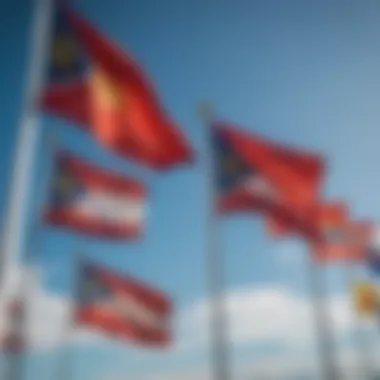
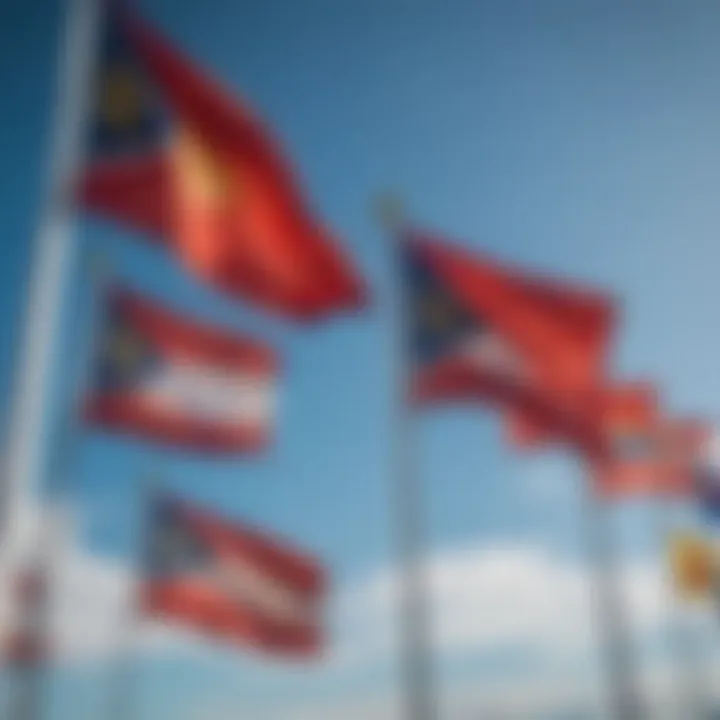
Intro
The world of marine flags is a vast ocean of colors and meanings that can seem overwhelming at first glance. These flags serve as vital tools of communication for sailors, boaters, and anyone involved in maritime activities. Imagine standing on a ship, the salty breeze tousling your hair while the colors of these flags dance in the wind. Each hue and pattern is not just a decorative element but a significant piece of information, steeped in history and crafted with precision.
Marine flags have been around for centuries, serving various purposes such as signaling distress, indicating nationality, or simply conveying important messages from one vessel to another. Most of us might recognize a few common flags, like the well-known distress signal, but there's so much more beneath the surface.
As you delve into this guide, you'll uncover the fascinating stories behind these flags, the intricate codes they embody, and the etiquette that governs their use. Along the way, we also examine how marine flags have evolved over time in response to changing technology and international maritime law. This exploration is not just for the seasoned sailor; it’s for anyone with an adventurous spirit and a hunger for knowledge about life on the water. Buckle up, because we’re about to cast off into the depths of marine flag symbolism.
Preamble to Marine Flags
Marine flags serve as a vital aspect of maritime culture and communication. They embody an intricate language that resonates deeply among sailors, boaters, and maritime enthusiasts. Understanding marine flags is essential, not just for operational matters but also for fostering a sense of community and shared knowledge among those who navigate the vast oceans and waterways.
Historical Context
To fully grasp the significance of marine flags, it’s helpful to peel back the layers of their history. The origins of using flags for maritime communication can be traced back centuries. The first documented use appears in the Middle Ages, where distinct banners represented different nations or fleets. As maritime trade grew, so did the need for clear communication at sea. Each flag’s design was not merely decorative; it communicated messages about a vessel’s status, intentions, or even its cargo.
For instance, during the Age of Sail, ships often used flags to indicate their national allegiance. This practice was crucial in avoiding conflicts and ensuring safe passage, especially in waters frequented by pirates and rival nations. In this context, flags served both ceremonial and practical purposes, making them a cornerstone of maritime culture.
Throughout the years, the International Code of Signals emerged in the 19th century, formalizing the use of flags and streamlining communication processes among nations. While technology has advanced, the essence of flags remains vital. They are an evolutionary symbol of human connection, akin to a sailor’s handshake across the water.
Importance of Communication at Sea
Effective communication at sea is not just about exchanging pleasantries; it’s a matter of safety, navigation, and operational efficiency. Marine flags have become this universal language that transcends language barriers.
They convey critical information such as:
- Navigational Instructions: Certain flags indicate whether a vessel is maneuvering or at anchor.
- Safety Alerts: Flags can signal emergencies or call for assistance, which can be lifesaving.
- Status Indication: Marine flags identify heading back to port, carrying cargo, or requiring other vessels to keep their distance.
The significance of these flags cannot be understated. Imagine a heavily loaded cargo ship needing to signal its intentions to a busy port. The clarity that flags provide can avert potential disasters and streamline operations. Every flag has a purpose, and ignorance of their meanings can lead to misunderstandings that might jeopardize maritime safety.
In a nutshell, the study of marine flags not only enriches one’s boating experience but is indispensable in ensuring harmonious and safe interactions at sea. Their historical roots and enduring purposes serve as a reminder of our shared responsibility towards maintaining safe maritime practices.
Types of Marine Flags
Understanding the various types of marine flags is crucial for anyone involved in maritime activities. Different flags serve distinct purposes, acting not only as symbols but also as essential communications tools. The myriad types create a rich tapestry that reflects different cultural facets and practical needs within the maritime domain. Knowing the types enhances safety, assists navigational awareness, and fosters a sense of community among mariners. Whether you are a seasoned sailor or a newcomer exploring the open waters, grasping the intricacies of marine flags will elevate your understanding of maritime communication.
International Signal Flags
International signal flags form a key part of maritime communication, designed to transmit messages between vessels, regardless of their nationality. The system employs 26 flags corresponding to the letters of the alphabet, with each flag also conveying a specific meaning. For instance, the flags for 'A' (Alfa) and 'B' (Bravo) hold weighty significance.
- 'A' signifies "I have a diver down; keep well clear at slow speed."
- 'B' communicates, "I am taking in or discharging dangerous cargo."
What sets these flags apart is their global recognition, which prevents misunderstandings at sea. It's like having a universal language that goes beyond words, fostering safe navigation. By learning these flags, operators can relay essential messages from ship to ship while displaying the utmost professionalism.
National Ensigns
National ensigns signify a country's maritime identity, flying proudly at the stern of vessels. Each flag tells the story of a nation’s maritime heritage, colors, and symbols that reflect its values and history. For example, the United States flag, known as the Stars and Stripes, is steeped in traditions that symbolize freedom and bravery. Conversely, the United Kingdom's Union Jack highlights a long-standing naval might.
The duty of displaying a national ensign goes beyond aesthetics. It represents the laws and protocols governing the ship's operations. Mariners often are required to fly their national flag to assert their jurisdiction and clarify their legal position on the waters. This flag is essential for respect and diplomacy among different nations on the seas.
Private Signal Flags
Private signal flags are more personal, often utilized by yacht owners or private vessels to communicate specific information or identities not covered by the international signal system. These flags can range from unique insignias representing family crests to personal logos. Mainly, they serve two purposes:
- Identification - They let other vessels know who they are dealing with, fostering a sense of familiarity and trust on the water.
- Communication - Private flags can convey non-verbal messages, such as an invitation to join for dinner or a request for assistance.
Each private flag is a unique reflection of the owner's personality or the vessel's name, adding flavor to the marine landscape. Understandably, misinterpretations can arise, so clarity is key in their usage.
"The flags don’t just wave; they speak a language all their own."
Navigating through these different categories of marine flags reveals a structure that supports maritime activities, bolsters safety, and enhances communication. By engaging with each type, you enrich not only your personal maritime experience but also contribute to a broader understanding of the sea's rich cultures and practices.
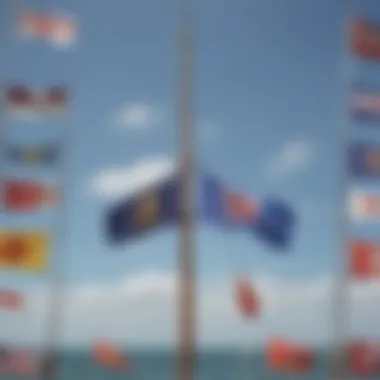
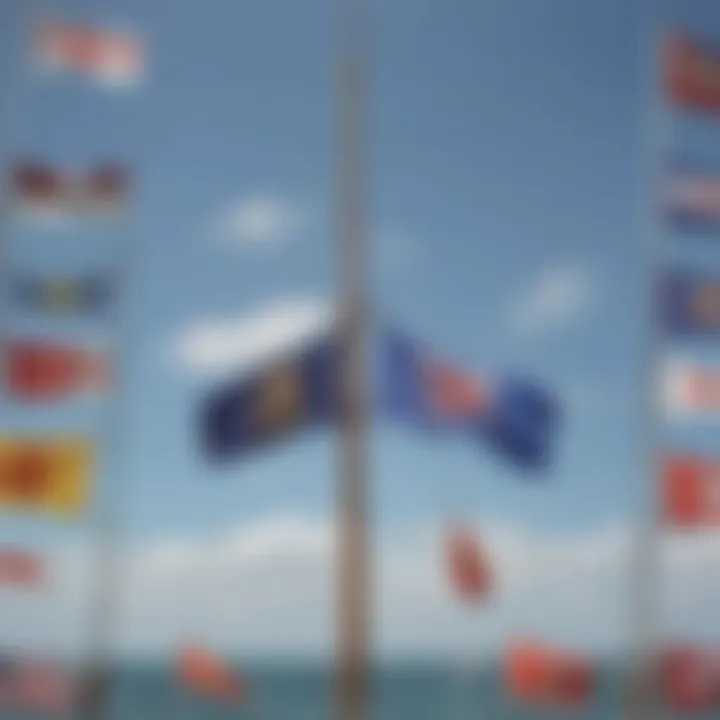
The Role of Color and Design
When discussing marine flags, the conversation naturally drifts toward their colors and designs. This is not mere decoration; each hue and symbol painted on these vibrant fabrics holds substantial weight in conveying messages across vast stretches of water. A sailor scanning the horizon for signals needs to grasp these visual cues swiftly. After all, life can depend on understanding that bright blue ‘A’ doesn’t just signify something trivial— it’s a call for assistance.
Even the smallest detail in design can carry a hefty load of meaning. In choking down the nuances of marine flags, we uncover the artistry and thought that has gone into their creation. When a flag flutters in the wind, it’s not just a spectacle for onlookers—it’s an essential tool for safe navigation and coordination in maritime scenarios.
Symbolism of Colors
The spectrum of colors on marine flags goes beyond aesthetics. Each color symbolizes a set of ideas or actions that are crucial for maritime communication.
- Red, often associated with danger, signifies urgency or a call for immediate attention. For example, a red flag means ‘stop’ or ‘danger’ and must be taken very seriously by asking for confirmation of the intention behind it.
- Yellow denotes caution. It might be flying to inform vessels to maintain distance or approach carefully—like a warning sign on the road.
- Blue is mainly used to denote safety or communication—think of it as the calm after the storm. A blue flag signals that it is safe to proceed.
- Green is generally a sign of safe passage or indicates that a vessel is operating normally.
It’s critical for those navigating the waters to understand these color codes. Misinterpretation can lead to dangerous situations on the water.
Design Patterns and Their Meanings
The design patterns add another layer to the understanding of these flags. Whether it’s stripes, shapes, or even letters, each design holds a significance worth noting.
- Stripes, such as the ones found on the U.S. Merchant flag, serve not just for decoration but as identifiers of nationality or a ship's purpose. The arrangement and color combination can hint at historical influences or geographical locations.
- Letters and Numbers are part of the International Code of Signals. Each flag represents a letter of the alphabet, and combinations of these flags can convey complex messages. For instance, the message “I am altering my course to starboard” can be relayed using a specific combination of flags.
- Symbols like anchors, stars, or compasses often tell a story about the vessel's mission or heritage. They are a nod to the past while communicating the present.
Understanding these symbols can be likened to knowing the lingo in a new language. The more fluent you are, the better your ability to navigate maritime life.
Understanding the International Code of Signals
The International Code of Signals is a vital component of maritime communication, acting as a universal language that bridges the gap between vessels from different countries. The importance of this code cannot be overlooked. In a world where maritime traffic is on the rise, having a standardized method to convey essential messages is crucial. Ships may find themselves navigating through intricate waters with diverse crews, and the ability to communicate clearly can spell the difference between smooth sailing and potential disaster.
The Code serves multiple purposes. Firstly, it ensures safety at sea by allowing vessels to relay critical information related to emergencies, navigation, and operational commands. Imagine a boat in distress, waving a flag high in the air, signaling for help. The International Code offers a structured way to communicate such urgent needs effectively.
Additionally, it fosters cooperation and understanding among vessels. Often, cultural barriers can lead to miscommunication, especially in the international waters where ships from various parts of the globe converge. The Code serves as a beacon, guiding sailors towards clearer dialogue, helping to prevent misunderstandings that could lead to grave consequences.
Overview of the Code
At its core, the International Code of Signals consists of a series of flags that represent letters of the alphabet, numbers, and certain special meanings. Each flag can be used individually or in combination to convey a specific message. This allows for a highly flexible system that can adapt to various situations.
Simply put, if a vessel needs to send a message regarding its status, such as "I am sinking," it can raise the appropriate flags in sequence to relay this message clearly. Each flag bears a distinct design and color, which helps distinguish its meaning from a distance, even when visibility may not be optimal.
This system not only enhances operational efficiency but also ensures that crew members aboard are prepared for various situations, whether in routine operations or emergencies.
Complete List of Signal Flags
Understanding the full scope of signal flags can be a bit daunting due to their extensive variety. Here's a brief overview:
- Flag A (Alpha): Represents "I have a diver down; keep well clear at slow speed."
- Flag B (Bravo): Indicates "I am taking in, or discharging, dangerous goods."
- Flag C (Charlie): Means "Yes."
- Flag D (Delta): Signifies "Keep clear of me; I am maneuvering with difficulty."
- Flag E (Echo): Used for the message "I am altering my course to starboard."
- Flag F (Foxtrot): Denotes an emergency, with the meaning "I am disabled; communicate with me."
The international maritime community relies heavily on the code's clarity, underscoring how effective signals can dramatically impact safety and navigation.
This is just a sample, as there are many more flags, each carrying important messages that contribute to maritime safety. Understanding these flags is an essential skill for any maritime professional and enhances the communication abilities for recreational boaters.
In concluding this overview, it's worth mentioning that while the basics can be quickly learned, mastering the International Code of Signals is a continual process. Regular practice and a solid grasp of its usage are paramount for effective maritime communication.
Flag Etiquette and Protocol
Flag etiquette isn't just a matter of tradition; it's a cornerstone of maritime communication. Just like in any community or culture, there are unspoken rules governing how we interact, and flags are no different. These colorful signals hold significant meanings, and their proper display ensures clarity and respect on the water. Understanding these protocols not only fosters a safe sailing environment but is also a mark of professionalism and mutual respect among seafarers.
Displaying Flags Correctly
Displaying flags correctly is essential for maintaining clear communication and adhering to the customs of maritime protocol. Each flag has its own unique meaning and purpose, and they must be raised in the right manner for their messages to be communicated effectively.
- Position Matters: Flags should be flown from the correct position on the vessel. Typically, the national flag is displayed at the stern, while signal flags should be raised at the masthead or in a position where they are visible and honors their significance.
- Orientation: Flags should be hung with respect to their proper orientation. For instance, when displaying a national ensign, ensure that the design is upright. An incorrectly displayed flag can lead to misunderstandings or perceived disrespect.
- Weather Considerations: Be mindful of the weather conditions. Flags should be flown in a way that ensures they do not get damaged by harsh winds or rain. Adjusting the height at which they are flown can help in avoiding potential wear and tear.
In essence, displaying flags correctly reflects the standards of the maritime community, illustrating an understanding of their significance. It builds a culture of safety and respect.
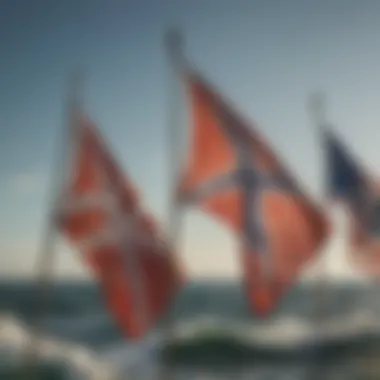
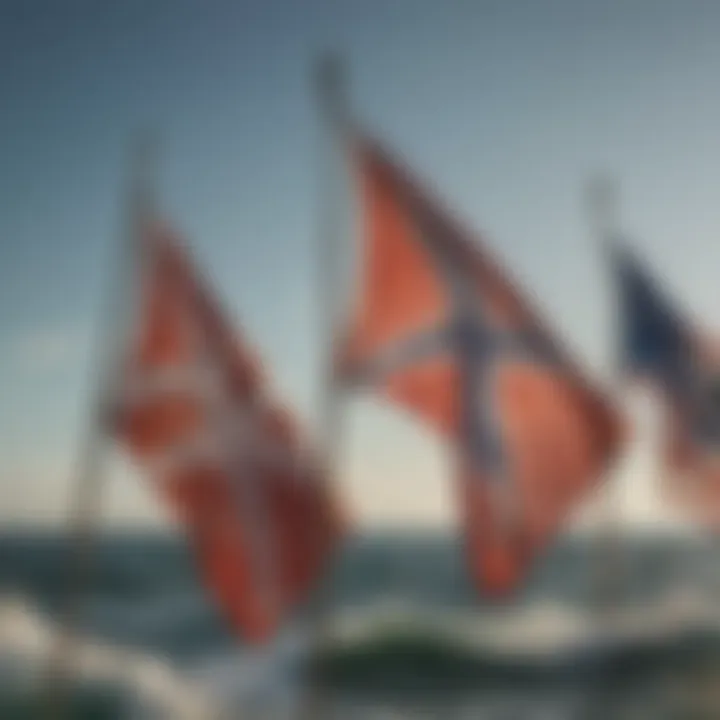
Raising and Lowering Protocols
The rituals surrounding raising and lowering flags are steeped in tradition and signify respect not only for the flags themselves but also for the history they represent.
- Timing: Flags should be raised at a specific time of day, generally at sunrise, and appropriately lowered at sunset. This aligns with long-standing maritime tradition and helps maintain the dignity associated with the flags.
- Ceremony: Often, there are ceremonial practices associated with flag raising and lowering. This could involve a brief pause or a salute, particularly for national flags. Engaging in this practice reflects a sailor's pride in their nation and adherence to maritime customs.
Proper flag etiquette promotes a respectful atmosphere, facilitating better communication while enhancing the aesthetic of the maritime journey.
- Order of Flags: Respect the hierarchy among flags. National flags take precedence over others, followed by maritime signal flags and personal ensigns. This hierarchy maintains clarity regarding the vessel's identity and intentions.
Practical Use of Marine Flags
The utilization of marine flags is not merely a vestige of maritime culture; it is a fundamental aspect of operational communication. In an ecosystem characterized by vast expanses of water, where visibility can shift drastically due to weather or distance, flags serve as a bridge for conveying essential information. Understanding the practical applications of marine flags provides insights into their significance, transcending their decorative nature and grasping their role as critical tools in maritime communication.
Marine flags enhance safety, facilitate coordination, and promote adherence to regulations, making them invaluable to anyone venturing onto the water. Let’s navigate the two main fields where marine flags are prominently used: commercial shipping and recreational boating.
In Commercial Shipping
In the bustling world of commercial shipping, flags play a pivotal role. Every day, cargo ships and tankers traverse oceans, carrying goods across countries and continents. Proper flag protocols ensure smooth communication between these vessels and the port authorities or other vessels navigating the waters.
Key aspects include:
- Port Communication: Vessels display flags to signal their intentions, like anchoring or requesting pilot assistance. This immediate visual cue enables efficient harbor operations.
- Safety Alerts: Flags can indicate distress, a need for assistance, or hazardous conditions aboard. For instance, the International Code of Signals includes flags designated to signal emergencies, which can be critical in avoiding accidents at sea.
- Regulatory Compliance: Different flags signal compliance with laws regarding cargo types, hazardous materials, or specific environmental regulations. Failure to adhere to these can lead to costly fines or operational delays.
- Merchant Navy Identification: National flags denote the vessel's home country, fostering allegiance and compliance with international maritime laws.
In essence, the maritime industry thrives on this silent yet eloquent language that flags create. A failure to recognize or use these signals can have far-reaching consequences not just for individual vessels, but for entire supply chains.
In Recreational Boating
In the realm of recreational boating, flags take on a slightly different hue yet retain their critical communication role. Here, they enhance the experience, contribute to safety, and foster a sense of community among boaters.
Considerations for recreational use include:
- Social Signals: Flags often signal friendliness, gatherings, or events among boaters. For example, using a certain flag indicates that a boat is open for socializing or welcoming visitors.
- Safety and Warning Flags: Specific flags convey crucial safety information. A diver down flag signals to others to keep clear of an area, reducing potential accidents when divers are submerged. This can save lives.
- Racing and Competition: In sailing and water sports, the starting and finishing lines are demarcated by flags, directing competitors and managing races. Awareness of these flags and their meanings is vital for any participant.
- Personal Expression: Flags can also reflect personal tastes or affiliations, allowing boaters to brand their vessels uniquely. Displaying specific flags may denote club membership or maritime heritage.
In summary, whether navigating the high seas for commercial reasons or enjoying a leisurely day on a lake, the practical use of marine flags remains an indelible part of maritime culture. These brightly colored pieces of fabric harbor meaning far beyond their aesthetic appeal, linking the past with the present and ensuring safe, effective communication both on vast waters and at crowded docks.
Proper flag signaling not only displays intentions but it also contributes significantly to safe navigation and the maritime community's functionality.
Categorically, both commercial shipping and recreational boating depend heavily on the correct understanding and application of marine flags. As the maritime landscape evolves, so too will the practices surrounding the use of these essential instruments.
Common Misconceptions
When it comes to marine flags, a number of persistent myths and misunderstandings abound. Addressing common misconceptions about these nautical symbols is vital, as it helps clarify the essential role of flags and their meanings in maritime communication. By debunking these inaccuracies, enthusiasts and professionals can foster a more informed community, ensuring the proper usage of flags in various contexts.
Misinterpretations of Flag Meanings
One common myth is that many believe each flag represents a single phrase or idea. While it's true that flags have significations, their meanings are often context-dependent. Take, for instance, the letter 'S' flag, which signifies 'Stop!' when used in certain maritime communications. However, it can also relate to diverse maritime signals depending on the situation.
Additionally, people often think that flags are only for international maritime use. Yet, national flags, which serve as the identifiers for vessels, are equally important. In regional waters, these flags communicate different statuses and intentions. Misinterpreting such flags can lead to confusing situations at sea. Therefore, understanding the context behind a given flag’s display is crucial for effective communication.
"A flag at sea is worth a thousand words, but only if you read it right."
Another fallacy surrounds the belief that visual traits like color or design can easily dictate a flag's meaning. While colors do bear important symbols, interpretation is nuanced. For instance, red often indicates danger or alertness, but when coupled with a specific pattern, its meaning can change entirely. A closer examination of design elements provides better insight into how these symbols function collectively rather than individually.
Cultural Variations
Cultural interpretations of marine flags can create a minefield of misunderstandings. In some regions, a flag that signifies one thing in one context might hold a significantly different meaning elsewhere. For example, the same colors or patterns might be used in local celebrations or traditional events, which can confuse mariners unfamiliar with that context. Understanding the local maritime customs is not just a nice-to-know; it’s essential for safe navigation.
Furthermore, the historical context of how nations adopted their flags plays a huge part in their meanings. This layering of context means that a ship displaying a flag may be sending multiple messages—intended and unintended—depending on who is observing it.
- National flags: Generally reflect the history of nations, sometimes steeped in deep historical significance.
- Private flags: May embody personal or familial symbolism that doesn’t translate beyond local or family circles.
- Racing flags: Have meanings that vary significantly in competitive settings compared to recreational uses.


Navigating through the rich tapestry of cultural variations requires a nuanced understanding—one that goes beyond appearances to grasp the heartfelt significance attached to each flag.
Influence on Modern Watersports
The significance of marine flags in modern watersports cannot be overstated; they serve as a bridge between tradition and contemporary practices. As water activities continue to evolve, the role flags play in communication and safety remains crucial. These colorful symbols are not just relics from the past but vital elements that enhance both training and competition in today's aquatic sports landscape.
Training and Safety Programs
Incorporating marine flags into training programs ensures that participants understand not just how to sail or operate a vessel but also how to communicate effectively on the water. Training protocols often include flag recognition as an essential skill. For instance, learners are taught to identify the significance of individual flags like the Alpha flag, which signals divers in the water, or the Romeo flag, indicating that the vessel is preparing to anchor. This knowledge fosters a deeper respect for safety practices among enthusiasts and professionals alike.
The benefits go beyond mere understanding; they enhance safety management. Flag signals are a quick and efficient means of transmitting messages in potentially dangerous situations. Consider this scenario: a sailor spots a flag meaning 'man overboard.' Instant recognition means that help can be dispatched immediately, potentially saving a life. Training that includes flags often sets the stage for a safer environment on the water. Thus, learning to read flags can enhance situational awareness significantly, which is invaluable when out on open waters where conditions can change in a wink.
Integration into Racing and Competitions
In racing environments, flags take on multidimensional roles, serving as indicators of course changes, safety alerts, and even competitor statuses. For example, a yellow flag might inform racers of a caution area on the course, while a checkered flag at the finish line signals the end of the race. Each of these captures more than just a moment; they encapsulate a wealth of information distilled into a simple, universally understood visual cue.
Competitors and organizers alike rely heavily on flags, as they streamline the communication process. Races can get chaotic—sailors navigating through each other, wind shifts, or changing tides create a unique blend of excitement and confusion. In those times, clear signals can mean the difference between a smooth experience and a miscommunication that leads to accidents or disqualifications.
Including flag signals in competitive training also allows participants to engage with the sport on a deeper level. For instance, knowing what different flags indicate can empower sailors to respond swiftly and appropriately, thus enhancing their overall performance on the racecourse.
"Effective communication through flags can transform a chaotic race into a well-orchestrated event. It’s the language that we all understand, no matter where we come from."
As watersports continue to grow in popularity, so does the importance of flags. They provide a sense of structure amidst the fluid unpredictability of sailing and racing while honoring the rich maritime tradition.
In summary, the synergy between marine flags and modern watersports is an ever-evolving landscape that reflects both heritage and innovation, essential for both training and safety protocols as well as for competitive environments.
The Future of Marine Flags
As we sail further into the 21st century, the world of marine flags is on the brink of significant change. The evolution of these colorful symbols is not just about maintaining tradition; it’s about adapting to new technologies and the complexities of modern maritime activities. In an age where communication is instant, the role and relevance of marine flags must be re-evaluated to ensure they continue to serve their purpose effectively.
There is strong momentum towards modernization, and this encompasses both technological advances and efforts toward global standardization. These developments promise to enhance the functionality and efficiency of marine flags in various contexts, particularly in training and competitive environments.
Technological Advances
The digital age brings a new wave of possibilities for the use of marine flags. One notable advancement is the introduction of digital signal displays. These provide real-time updates and can convey messages with greater clarity than traditional flags. For instance, maritime apps are emerging that allow boats and ships to receive incoming signals on their screens, thereby reducing the reliance on physical flags.
This tech-centered approach not only simplifies communication but also increases safety on the waters. Imagine a scenario where a sailboat in a busy harbor receives continuous notifications about weather changes or navigational hazards, all without having to glance up at a flag hoisting high. The transition toward such technologies must be careful. It’s essential to maintain a balance—preserving the rich heritage of marine signaling while embracing the future.
Additionally, drone technology is being explored for signaling. Imagine a drone equipped with a digital display flying over a regatta, showing changing messages to help spectators understand race developments or to signal emergencies. The seas of tomorrow may very well blend age-old communication methods with avant-garde technology.
Global Standardization Efforts
The call for global standardization cannot be overstated. In the maritime world, consistency in communication is crucial, especially for international shipping lanes where many vessels from different countries converge. A globally unified flag system would minimize misunderstandings and increase overall safety at sea.
Organizations like the International Maritime Organization (IMO) are propelling efforts to create a more standardized language through marine flags. By promoting uniform design and meaning of flags across nations, seafarers—be they in bustling ports or desolate waters—would navigate with less ambiguity. Such cooperation not only fosters goodwill among different maritime nations but also enhances the operational efficiency of the entire shipping industry.
The future of marine flags hinges on the delicate balance between modernity and tradition. As technology shapes the way we communicate, it is vital that the maritime community embraces these changes thoughtfully. The importance of keeping a universal standard cannot be overlooked either. Only then can the language of the sea remain relevant and effective in the maritime communications of tomorrow. This ongoing transformation may redefine what it means to signal at sea, but the essence of heralding safety and clarity will remain unchanged.
"Innovation in marine flag technology must not erase the rich traditions, but build upon them for a safer maritime world."
In this context, understanding the imminent shifts in marine flags equips enthusiasts and professionals alike to adapt effectively to the changing tides.
End
In concluding our exploration of marine flags, it's critical to acknowledge how these vibrant symbols serve not just as mere decorations, but as vital tools for communication at sea. Throughout various sections of this article, we examined the historical significance and the different types of flags used in maritime activities. However, their importance goes far beyond simple identification or signaling. Marine flags are integral in ensuring safety, enhancing operational efficiency, and fostering international maritime relations. As the waters become more crowded, understanding the meanings behind these flags can be a lifesaver.
Reflecting on Marine Flags
The essence of marine flags lies in their ability to convey complex messages through simple imagery. Each flag carries a story, a tradition, or a need for communication that transcends language barriers. Take, for example, the intricate design of the international signal flag "A" (Alfa), which signifies "I have a diver down; keep well clear at slow speed." This simple design serves a lifesaving purpose, illustrating that colors and patterns can represent crucial information.
Going beyond simple functionality, these flags also offer a glimpse into the cultures and histories of nations. The blend of colors and the specific designs often reflect a country’s naval heritage or significant historical events. Thus, when one sees a merchant ship adorned with its national ensign, it echoes tales of bravery, exploration, and evolution in maritime practices.
The Continued Relevance of Flags in Maritime Contexts
As maritime technology evolves, one might wonder whether traditional flags will become obsolete. In reality, marine flags maintain their relevance and importance, even in modern contexts. While technology offers advanced forms of communication, such as radio and digital signaling, the universal symbolism of flags still plays a significant role. It is not uncommon for sailboats in regattas to rely on flags for announcements, marking race starts and finishes, which creates a vibrant visual language amid the competition.
Furthermore, the continued emphasis on safety in maritime practices cannot be overstated. The reliance on flags ensures that even in situations where electronic systems may fail, crew members can communicate effectively through the resilience of these time-tested symbols.
In summary, whether seen on international cargo ships or small recreational vessels, marine flags remain indispensable. They not only preserve important traditions but also adapt to modern needs, proving that their role in maritime communication can’t be easily dismissed. For water sports enthusiasts and professionals alike, having a solid grasp of these flags enhances situational awareness, safety, and community within the maritime world.















